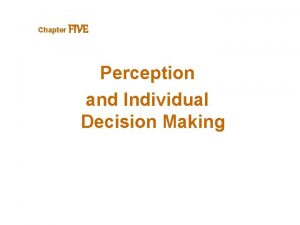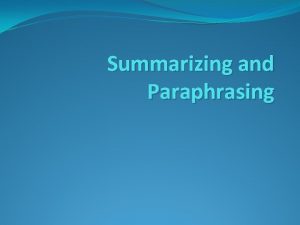PARAPHRASING Definition A distilled version of the content





- Slides: 5

PARAPHRASING Definition: • “A distilled version of the content of the client’s message that restates the facts and thoughts in different words in a nonjudgmental way. ” (p. 90)

FACT Oxford Dictionary definition: “A thing that is indisputably the case”. That is, no one can argue that it isn’t true. Answers the question, 'what happened’: who, what, where, when, how All cultures have ways to determine facts: • • Personal accounts (It happened to me so I know it is true) Descriptions that include the 5 senses (Also called “phenomenology”) People who share an experience can verify it happened Debate among reasonable people (E. g. a jury) Science Expertise from training or study (expert carpenter, expert biologist) People with power seem to know more than others (politicians, famous people, religious figures) Facts are a matter of perception. Which of the above do you believe?

PARAPHRASING Goals: • For the client to feel understood • For the client to see that you as therapist can take on his or her perspective Two steps: • Listening carefully to the client’s story • Feeding back to the client a condensed, nonjudgmental version of the facts and thoughts.

PRINCIPLES FOR SKILLFUL PARAPHRASING Your paraphrased statements should: • Be brief • Includes most relevant facts • Stay neutral: doesn’t blame the client and doesn’t take the client’s side • Use your own words to show you understand the client • Include facts and thoughts even if they are conflicting • Usually do not include feelings or deeper meanings

PARAPHRASING PRACTICE Speaker: Think about your everyday life (as you did in making your map). Tell a story about someone who got in your way or someone who helped you in the last couple of weeks. Tell the story of what happened, including the location, environment, time of day, people involved, and any other details. Listener: Paraphrase the Speaker's story. Speaker: See how you feel when the Listener paraphrases your story. Do you feel understood? If not, tell the Listener what they missed. Listener: If the Speaker feels understood, trade roles. If not, try to paraphrase again, based on what the Speaker says you missed.









